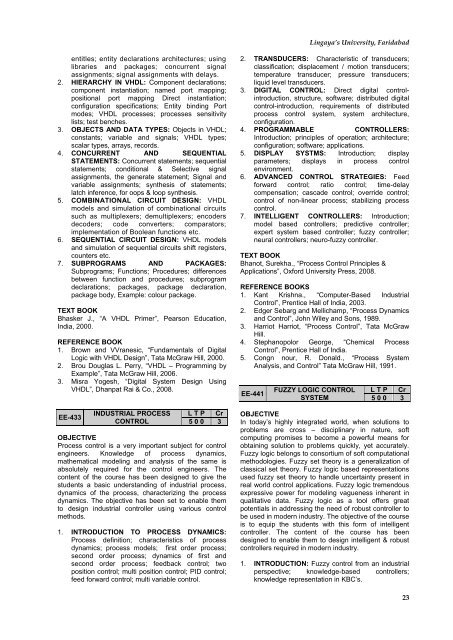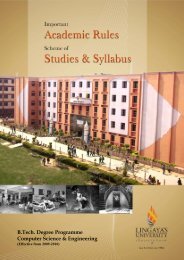Electrical and Electronics - Lingaya's University
Electrical and Electronics - Lingaya's University
Electrical and Electronics - Lingaya's University
You also want an ePaper? Increase the reach of your titles
YUMPU automatically turns print PDFs into web optimized ePapers that Google loves.
Lingaya’s <strong>University</strong>, Faridabadentitles; entity declarations architectures; usinglibraries <strong>and</strong> packages; concurrent signalassignments; signal assignments with delays.2. HIERARCHY IN VHDL: Component declarations;component instantiation; named port mapping;positional port mapping Direct instantiation;configuration specifications; Entity binding Portmodes; VHDL processes; processes sensitivitylists; test benches.3. OBJECTS AND DATA TYPES: Objects in VHDL;constants; variable <strong>and</strong> signals; VHDL types;scalar types, arrays, records.4. CONCURRENT AND SEQUENTIALSTATEMENTS: Concurrent statements; sequentialstatements; conditional & Selective signalassignments, the generate statement; Signal <strong>and</strong>variable assignments; synthesis of statements;latch inference, for oops & loop synthesis.5. COMBINATIONAL CIRCUIT DESIGN: VHDLmodels <strong>and</strong> simulation of combinational circuitssuch as multiplexers; demultiplexers; encodersdecoders; code converters; comparators;implementation of Boolean functions etc.6. SEQUENTIAL CIRCUIT DESIGN: VHDL models<strong>and</strong> simulation of sequential circuits shift registers,counters etc.7. SUBPROGRAMS AND PACKAGES:Subprograms; Functions; Procedures; differencesbetween function <strong>and</strong> procedures; subprogramdeclarations; packages, package declaration,package body, Example: colour package.TEXT BOOKBhasker J., ―A VHDL Primer‖, Pearson Education,India, 2000.REFERENCE BOOK1. Brown <strong>and</strong> VVranesic, ―Fundamentals of DigitalLogic with VHDL Design‖, Tata McGraw Hill, 2000.2. Brou Douglas L. Perry, ―VHDL – Programming byExample‖, Tata McGraw Hill, 2006.3. Misra Yogesh, ―Digital System Design UsingVHDL‖, Dhanpat Rai & Co., 2008.EE-433INDUSTRIAL PROCESSCONTROLL T P Cr5 0 0 3OBJECTIVEProcess control is a very important subject for controlengineers. Knowledge of process dynamics,mathematical modeling <strong>and</strong> analysis of the same isabsolutely required for the control engineers. Thecontent of the course has been designed to give thestudents a basic underst<strong>and</strong>ing of industrial process,dynamics of the process, characterizing the processdynamics. The objective has been set to enable themto design industrial controller using various controlmethods.1. INTRODUCTION TO PROCESS DYNAMICS:Process definition; characteristics of processdynamics; process models; first order process;second order process; dynamics of first <strong>and</strong>second order process; feedback control; twoposition control; multi position control; PID control;feed forward control; multi variable control.2. TRANSDUCERS: Characteristic of transducers;classification; displacement / motion transducers;temperature transducer; pressure transducers;liquid level transducers.3. DIGITAL CONTROL: Direct digital controlintroduction,structure, software; distributed digitalcontrol-introduction, requirements of distributedprocess control system, system architecture,configuration.4. PROGRAMMABLE CONTROLLERS:Introduction; principles of operation; architecture;configuration; software; applications.5. DISPLAY SYSTMS: Introduction; displayparameters; displays in process controlenvironment.6. ADVANCED CONTROL STRATEGIES: Feedforward control; ratio control; time-delaycompensation; cascade control; override control;control of non-linear process; stabilizing processcontrol.7. INTELLIGENT CONTROLLERS: Introduction;model based controllers; predictive controller;expert system based controller; fuzzy controller;neural controllers; neuro-fuzzy controller.TEXT BOOKBhanot, Surekha., ―Process Control Principles &Applications‖, Oxford <strong>University</strong> Press, 2008.REFERENCE BOOKS1. Kant Krishna., ―Computer-Based IndustrialControl‖, Prentice Hall of India, 2003.2. Edger Sebarg <strong>and</strong> Mellichamp, ―Process Dynamics<strong>and</strong> Control‖, John Wiley <strong>and</strong> Sons, 1989.3. Harriot Harriot, ―Process Control‖, Tata McGrawHill.4. Stephanopolor George, ―Chemical ProcessControl‖, Prentice Hall of India.5. Congn nour, R. Donald., ―Process SystemAnalysis, <strong>and</strong> Control‖ Tata McGraw Hill, 1991.EE-441FUZZY LOGIC CONTROLSYSTEML T P Cr5 0 0 3OBJECTIVEIn today‘s highly integrated world, when solutions toproblems are cross – disciplinary in nature, softcomputing promises to become a powerful means forobtaining solution to problems quickly, yet accurately.Fuzzy logic belongs to consortium of soft computationalmethodologies. Fuzzy set theory is a generalization ofclassical set theory. Fuzzy logic based representationsused fuzzy set theory to h<strong>and</strong>le uncertainty present inreal world control applications. Fuzzy logic tremendousexpressive power for modeling vagueness inherent inqualitative data. Fuzzy logic as a tool offers greatpotentials in addressing the need of robust controller tobe used in modern industry. The objective of the courseis to equip the students with this form of intelligentcontroller. The content of the course has beendesigned to enable them to design intelligent & robustcontrollers required in modern industry.1. INTRODUCTION: Fuzzy control from an industrialperspective; knowledge-based controllers;knowledge representation in KBC‘s.23
















